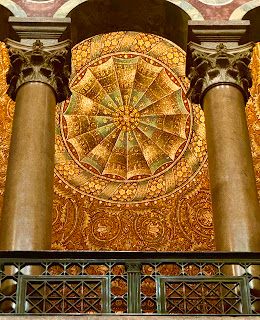Two nights. One full day to stretch our legs and explore somewhere new. Aachen became the first stop on our big German road trip.
More than a convenient layover, Aachen has been hovering on my must-see list since my AP Art History days. Despite the lure of its Charlemagne legacy, however, it’s never really made a splash on the modern tourism circuit. Which is precisely what made it appealing.
It also fit beautifully with our trip’s broader theme. Much of our itinerary was inspired by Piers’ ancestral research, which traced one family branch deep into medieval Saxony—and before that to Charlemagne himself. (Of course, statistically, anyone of European descent is likely descended from the great king. That’s just how exponential growth works.) Still, it’s thrilling when the tangled lines of genealogy align so neatly with your travel plans.
Step into Charlemagne’s cathedral in Aachen and the idea of a culturally stunted Europe cowering in the Dark Ages crumbles immediately. Built around 800 AD, this octagonal jewel box radiates opulence and ambition. Mosaic ceilings glitter with gold and blue ground from Afghan lapis lazuli, alabaster lamps glow softly, and Roman marble paves the floor.
If you’ve been to Ravenna, this will feel familiar. The church takes heavy inspiration from San Vitale, with its central dome and Byzantine elegance, and the blue starry ceilings of the side halls echo Galla Placidia’s mausoleum. From the centre of the cathedral, a massive brass chandelier dominates the space, while a second-story gallery—accessible only by guided tour—holds Charlemagne’s throne and the spot where centuries of Holy Roman Emperors were crowned. Sadly, tours weren’t running on Good Friday, but even from ground level, the mosaics and sense of grandeur astound.
In the 14th century, the Holy Roman Emperors added a gothic nave to their coronation church. It’s a glittering glass box reminiscent of Sainte-Chapelle in Paris. It houses Charlemagne’s golden sarcophagus, though access was limited during our visit. Still, the experience from the original octagon alone was so rich, I didn’t feel shortchanged.
The cathedral alone makes Aachen a worthwhile stop. But the town holds more delights. While much of its outer ring is post WW2 and there’s some brutal modernism even in the town centre, the town has done a good job keeping its core appealing.
The cathedral’s Treasury Museum is just a few steps away in some old cloisters, and ranks among the best of its kind. The modern presentation makes its medieval treasures shine. Of course there’s gold and gems galore, but the relics of Charlemagne steal the show. A jewel-encrusted bust contains part of his skull; a gilded arm reliquary holds a bone from his arm. The Cross of Lothair, set with an eclectic jumble of Roman cameos, is more ostentatious than beautiful—but its plain reverse, etched with a simple Christ figure, is quietly powerful.
My favourite object, however, was the crown of Margaret of York—sister to English Kings Edward IV and Richard III. It’s a typical high medieval circlet, all enamel, gold, and trefoils. But unique because, since Cromwell melted down all the Crown Jewels left in the UK, this is the only English-made medieval crown still in existence.
The town hall, just up the hill on a square surrounded by fine buildings, is a fantasy of medieval architecture, spiked with statues and twinkling with leaded glass. A neighbouring Renaissance gallery with twisted wooden columns now houses a tempting restaurant—though we opted for a lazier dinner closer to the hotel.
The Couven Museum, in a well-preserved bourgeois townhouse, offers a more relatable view of history. It’s filled with the trappings of an 18th- and 19th-century merchant family: tiled summer rooms, a complete pharmacy, and elegant Biedermeier salons. A quirky collection of miniature perfume bottles adds charm.
A neoclassical pavilion (which we'd call Regency in England, Biedermeier here) nods to Aachen’s 19th-century reinvention as a fashionable spa town—with, amusingly, a reputation for upscale prostitution. Sacred and profane, side by side.
We stayed at the Mercure Aachen, right in the heart of town, leaving our car in the nearby convention centre garage (€24 for the full visit). One day of sightseeing was plenty. Aachen was a sensible, fascinating, and satisfying pause on our route east. A kingly stopover—fitting, for a road trip inspired by family trees and imperial ghosts.
The Couven Museum, in a well-preserved bourgeois townhouse, offers a more relatable view of history. It’s filled with the trappings of an 18th- and 19th-century merchant family: tiled summer rooms, a complete pharmacy, and elegant Biedermeier salons. A quirky collection of miniature perfume bottles adds charm.
A neoclassical pavilion (which we'd call Regency in England, Biedermeier here) nods to Aachen’s 19th-century reinvention as a fashionable spa town—with, amusingly, a reputation for upscale prostitution. Sacred and profane, side by side.
We stayed at the Mercure Aachen, right in the heart of town, leaving our car in the nearby convention centre garage (€24 for the full visit). One day of sightseeing was plenty. Aachen was a sensible, fascinating, and satisfying pause on our route east. A kingly stopover—fitting, for a road trip inspired by family trees and imperial ghosts.








